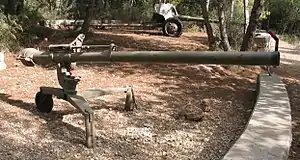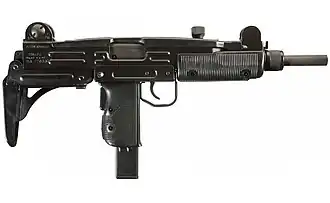Madagascar People's Armed Forces
The Madagascar Armed Forces (French: Forces armées de Madagascar, Malagasy: Tafika Malagasy) is the national military of Madagascar. The IISS detailed the armed forces in 2012 as including an Army of 12,500+, a Navy of 500, and a 500-strong Air Force.[4]
| Madagascar Armed Forces | |
|---|---|
| French: Forces armées de Madagascar Malagasy: Tafika Malagasy | |
 | |
| Founded | 1960 |
| Service branches | Malagasy Army Malagasy Air Force Malagasy Navy National Gendarmerie |
| Headquarters | Antananarivo |
| Leadership | |
| Commander-in-chief | Cabinet (acting)[1] |
| Minister of Defense | Leon Jean Richard Rakotonirina[2] |
| Chief of Staff | Division General Lala Monja Delphin Sahivelo[3] |
| Personnel | |
| Conscription | 18 months (military and non-military service) |
| Available for military service | 4,900,729 males, age 16-49 (2010 est.), 4,909,061 females, age 16-49 (2010 est.) |
| Fit for military service | 3,390,071 males, age 16-49 (2010 est.), 3,682,180 females, age 16-49 (2010 est.) |
| Reaching military age annually | 248,184 males (2010 est.), 246,769 females (2010 est.) |
| Active personnel | 13,500 (military) 8,100 (National Gendarmerie)[4] |
| Related articles | |
| Ranks | Military ranks of Madagascar |
The armed forces were involved in the 2009 Malagasy political crisis. During World War II, Malagasy troops fought in France, Morocco, and Syria.
History

The rise of centralized kingdoms among the Sakalava, Merina and other ethnic groups produced the island's first standing armies, first equipped with spears, but later with muskets, cannons and other firearms. King Ralambo (1575–1612) raised the first standing army in the highland Kingdom of Imerina with a handful of guns, although for at least two centuries the armies of the Sakalava were much larger and better equipped, possessing thousands of muskets obtained principally through trade with European partners.[5] By the early 19th century, however, the army of the Kingdom of Imerina was able to bring much of the island under Merina control.
Merina Queen Ranavalona, like her predecessors, utilized the tradition of fanampoana (service due to the sovereign in lieu of taxes) to conscript a large portion of the population of Imerina into military service, enabling the queen to raise a standing army that was estimated at 20,000 to 30,000 soldiers.[6] By the late 19th century French plans to colonize Madagascar were gaining momentum, leading British mercenaries to provide training to the queen's army in an unsuccessful bid to repel the French troops. Madagascar was colonized in 1896, and during World War II over 46,000 Malagasy soldiers were drafted to fight with the Allies, over 2,000 of whom died fighting for France.[7]
.jpg.webp)
Madagascar gained political independence and sovereignty over its military in 1960. Since this time Madagascar has never engaged in an armed conflict, whether against another state or within its own borders. As such the armed forces of Madagascar have primarily served a peacekeeping role. However, the military has occasionally intervened to restore order during periods of political unrest. When President Philibert Tsiranana was forced to step down in 1972, a military directorate ensured an interim government before appointing one of its own, Admiral Didier Ratsiraka, to lead the country into its socialist Second Republic. He launched a strategy of obligatory national armed or civil service for all young citizens regardless of gender. The majority were channeled into civil service, including agriculture and education programs for rural development based on the socialist Soviet model.[8] Ratsiraka would also mobilize elements of the military to pacify unarmed protesters, occasionally using violent means. His order to fire upon unarmed protesters in 1989 was the catalyst for transition to the democratic Third Republic in 1992. The military remained largely neutral during the protracted standoff between incumbent Ratsiraka and challenger Marc Ravalomanana in the disputed 2001 presidential elections. By contrast, in 2009 a segment of the army defected to the side of Andry Rajoelina, then-mayor of Antananarivo, in support of his attempt to force President Ravalomanana from power. It is widely believed that payoffs were involved in persuading these military personnel to change camps in support of the coup d'état.[7]
As of 2010, the military of Madagascar is composed of the 8,100 paramilitary of the National Gendarmerie and the 13,500 members of the Armed Forces. According to the International Institute of Strategic Studies' Military Balance 2010, the latter includes an Army of 12,500, a Navy of 500 and a 500-strong Air Force,[9] while the CIA Factbook describes the Armed Forces as consisting of the Intervention Force, Aeronaval Force (navy and air) and the Development Force. Military service is voluntary and limited to males aged 18 to 25; every citizen of either gender is required to have perform either military or civil service for a minimum of 18 months. However, because of a lack of up-to-date census data, this requirement is not currently enforced. The Gendarmerie recruits Malagasy citizens between the ages of 20 and 30 (or 35 if the recruit has prior military service). Military expenses constituted just over one percent of GDP.[10] Under Ravalomanana, military expenditure doubled from 54 million USD in 2006 to 103 million USD in 2008.[11]
Small arms
Anti-tank weapons
| Name | Image | Type | Origin | Caliber | Notes |
|---|---|---|---|---|---|
| M40A1[16] |  |
Recoilless rifle | 106mm |
Anti-aircraft weapons
| Name | Image | Type | Origin | Quantity | Status | Notes |
|---|---|---|---|---|---|---|
| ZPU[16] |  |
Anti-aircraft gun | 50 | INS | ||
| Type 55[16] |  |
Anti-aircraft gun | 20 | INS |
Artillery
| Name | Image | Type | Origin | Quantity | Status | Notes |
|---|---|---|---|---|---|---|
| Mortars | ||||||
| M-37[16] |  |
Mortar | Unknown | INS | ||
| PM-43[16] |  |
Mortar | 8 | INS | ||
| Towed artillery | ||||||
| M101[16] | _left_front_view_at_Camp_Nihonbara_October_1%252C_2017.jpg.webp) |
Howitzer | 5 | INS | ||
| D-30[16] | .jpg.webp) |
Howitzer | 12 | INS | ||
Tanks
| Name | Image | Type | Origin | Quantity | Status | Notes |
|---|---|---|---|---|---|---|
| PT-76[16] |  |
Amphibious Light tank | 12 | INS |
Armored vehicles
| Name | Image | Type | Origin | Quantity | Status | Notes |
|---|---|---|---|---|---|---|
| BRDM-2[16] | _owned_by_James_Stewart_pic7.JPG.webp) |
Amphibious armored scout car | 35 | INS | ||
| Ferret Mk.1/1[16] | _owned_by_Clive_Garton_pic1.JPG.webp) |
Armored car Scout car | 10 | INS | ||
| UR-416[16] |  |
Armoured personnel carrier | 5 | INS | ||
| M8 Greyhound[16] |  |
Armored car | 8 | INS |
Naval
.jpg.webp)
- 1 Chamois class patrol boat[4]
- 1 d'Entrecasteaux-Class patrol boat
- 1 Arras-Class aviso
- 6 La-Confiance patrol craft[4]
- 1 LCT (Mark-8 Class)[4]
- 2 Coastal patrol vessel of 26m: Tselatra and Malaky[17]
.jpg.webp)
Aircraft

Madagascar has a small air force (Armée de l'Air Malgache). A number of MiG-21s, MI-8, C-47 Dakota and An-26 were scrapped around 2012.[18]
| Aircraft | Origin | Type | Versions | In service | Notes |
|---|---|---|---|---|---|
| Cessna 172 Skyhawk | United States | Primary trainer | 172M | 4[4] | |
| Cessna 337 Skymaster | United States | Utility aircraft | 2[4] | ||
| Aero Synergie J300 Joker | FRA | Trainer | 2[4] | ||
| Humbert Tétras | FRA | 1[4] | |||
| Piper Aztec | United States | Communications | PA-23-250 Aztec D | 1[4] | |
| Eurocopter AS350 Écureuil | France | Multi-purpose helicopter | AS350B2 | 5 | [19] |
| MBB/Kawasaki BK 117 | Germany/Japan | Multi-purpose helicopter | 1 | [19] |
References
- https://africaelects.com/madagascar/
- "Indian envoy meets Madagascar defence minister, discusses issues of mutual interest". ANI News. 2021-08-03. Retrieved 2021-09-10.
- "DEFENSE NATIONALE – le général Lala Monja Delphin Sahivelo remplace le général Jean Claude Rabenaivoarivelo à la tête de". 17 June 2021.
- IISS (2012), p. 442
- Barendse, R. J. (2002). The Arabian seas: the Indian Ocean world of the seventeenth century. Berlin: M.E. Sharpe. pp. 259–274. ISBN 978-0-7656-0729-4. Retrieved April 1, 2011.
- Freeman, Joseph John; Johns, David (1840). A narrative of the persecution of the Christians in Madagascar: with details of the escape of six Christian refugees now in England. Berlin: J. Snow. Retrieved February 5, 2011.
- Bradt (2010), pp. 7-10
- Strakes, Jason (2006), "Armed Forces of the People", in Leonard, Thomas M. (ed.), Encyclopedia of the developing world, vol. 1, New York: Taylor & Francis, p. 86, ISBN 978-1-57958-388-0, retrieved April 1, 2011
- IISS Military Balance 2010, p.314-315
- Central Intelligence Agency (April 1, 2011). "The World Factbook: Madagascar". Retrieved April 1, 2011.
- IISS Military Balance 2010, p.467
- Jane's World Armies online edition (19 May 2011)
- "Post-WWII use of the MAS-36 rifle: Part II (export users)". wwiiafterwwii.wordpress.com. 2015-08-23. Retrieved 2017-06-15.
- Scarlata, Paul (December 2012). "Military rifle cartridges of Madagascar isolated but well armed!". Shotgun News.
- Strakes, Jason (2006), "Armed Forces of the People", in Leonard, Thomas M. (ed.), Encyclopedia of the developing world, vol. 1, New York: Taylor & Francis, p. 86, ISBN 978-1-57958-388-0, retrieved April 1, 2011
- International Institute for Strategic Studies (2021). The Military Balance. p. 473. ISBN 9781032012278.
- L'Express: 2 Patrouilleurs nouvaux
- Defenseweb: Madagascar receives new aircraft
- Martin, Guy (September 2019). "Madagascar's military receives more aircraft". Air International. Vol. 97, no. 3. p. 9. ISSN 0306-5634.
Bibliography
- Bradt, Hilary (2011). Madagascar, 10th Ed.: The Bradt Travel Guide. London: Bradt Travel Guides. ISBN 978-1-84162-341-2. Retrieved March 18, 2011.
- "The Military Balance 2010" (PDF). International Institute of Strategic Studies. pp. 314–315, 467. Archived from the original (PDF) on May 11, 2011. Retrieved April 1, 2011.
- International Institute for Strategic Studies (IISS) (2012). "The Military Balance 2012". The Military Balance: Annual Estimates of the Nature and Size of the Military Forces of the Principal Powers. London: IISS. ISSN 0459-7222.
- "Madagascar". Jane's World Armies (online edition). IHS Jane's. 19 May 2011.
{{cite web}}: Missing or empty|url=(help) - World Aircraft Information Files. Brightstar Publishing, London. File 339 Sheet 01
![]() This article incorporates public domain material from The World Factbook (2023 ed.). CIA. (Archived 2006 edition)
This article incorporates public domain material from The World Factbook (2023 ed.). CIA. (Archived 2006 edition)
External links
- Ministry of Madagascar National Defense (in French)
















.jpg.webp)



